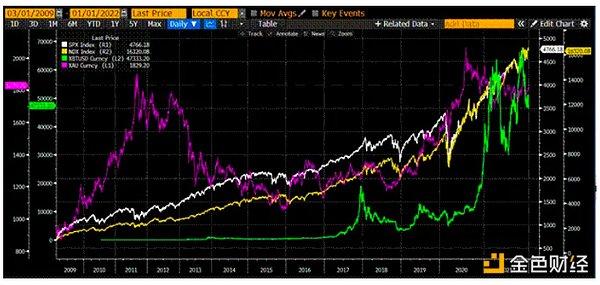Author: Hedy Bi, OKG Research
On the evening of March 3 (Beijing time), US President Donald Trump confirmed the imposition of tariffs on Canada and Mexico, taking reciprocal tariff action starting on April 2, dashing hopes of a last-minute deal with Canada and Mexico to avoid across-the-board tariffs.
In less than 48 hours, Bitcoin, which had just the previous day been buoyed by "crypto strategic reserves", plunged 8%. At the same time, the US stock market also suffered a tariff shock, with the Nasdaq index falling 2.6%. In just over a month since Trump took office, the crypto market capitalization has shrunk by 22%, and the Trump Media & Tech Group (DJT) has fallen 34.75%. Even Musk, who has always been a staunch supporter of Trump, has not been spared, with Tesla's stock price falling 32.87% due to the "crude and brutal" actions of the DOGE department and his excessive involvement in international politics.
Trump's words are tugging at the nerves of the crypto market, with a hint of "success through Xiao He, failure through Xiao He". In 2025, OKG Research will launch a special "Trump Economics" series, and the author will continue to track the impact of the Trump 2.0 government on the crypto market. In the previous article in this series, "A New Wave of Liquidity is Coming, Can the Crypto Market Break Through to New Highs?", we pointed out that the market should focus on real liquidity (in the short term, TGA can be focused on) rather than market news and rhetoric, and that without real liquidity support, the foreign exchange rally driven by "talk without action" cannot be sustained. Furthermore, according to the latest official data from US investors, since February 28, the TGA account has stopped injecting liquidity into the market, with a total of $304.9 billion injected into the market.
Tariff policy, as the first major blow, is having a huge impact on the global risk market with "American attributes". Will the removal of the destructive policies be a priority for both Trump 1.0 and 2.0? This article, as the fifth in the OKG Research 2025 special series "Trump Economics", will use the trade war as a framework to analyze the deeper implications of Trump's "left hand tariffs, right hand crypto".
Tariff "Chips"
Trump's bilateral commitments upon taking office were very clear, but the big stick first fell on tariffs.
On the surface, Trump's tariff hikes are aimed at reducing the trade deficit and boosting employment and the economy. But the trade wars of Trump 1.0 and the tariffs before 1930 have shown that this is not a "good deal". The US Congressional Budget Office (CBO) has shown that the trade war in 2018-2019 cost the US 0.3% of GDP, about $40 billion. Data from the Peterson Institute for International Economics shows that the 2018 aluminum tariffs alone cost the US manufacturing industry about 75,000 jobs. Furthermore, US companies have shifted production to countries like Vietnam and Mexico to rebuild domestic inventories (Carney). And the trade wars of other presidents have also failed to achieve good results: in 1930, the US implemented the Smoot-Hawley Tariff Act, and global trade recovered only about 66%. US exports fell by 67%, and the resulting price disruption led to massive unemployment.
Tariffs are just the beginning, with the Trump administration seeking to curb economic uncertainty and gain negotiating leverage. The core of the tariff game is not just the flow of goods, but also the collateralization of technology capital, liquidity, and currency competition. The essence of the trade war is not just tariff barriers, but a deep impact on the global financial system. From the foreign exchange market to the stock market, from global bond yields to asset risks, the capital market has not been spared.
Buffett has rarely spoken out to warn that punitive tariffs could fuel inflation and harm consumer interests. The impact on the real economy will further exacerbate the Fed's dilemma - how to control inflation without causing severe economic structural damage. Consumer confidence may drag down the economy, while inflationary pressures limit the Fed's room for rate cuts, ultimately leading to further tightening of liquidity and the Fed falling into a recession.
For the crypto market, as a participant in the global risk asset market sentiment, the market performance of crypto assets is no less volatile than that of US tech stocks. Whether it's the 70% dependence of Bitcoin's computing power on Nvidia GPU-driven miners, or the inclusion of crypto-related companies like Coinbase and MicroStrategy in the Nasdaq 100 index, US financial policies and regulatory safeguards have a deeper impact on the crypto market.
Relatively speaking, the crypto market is a derivative variable of US financial policy, rather than a hedging tool (see OKG Research article "Repositioning the Crypto Market: The Pains of Transformation in the Global Liquidity Dilemma", July 2024). In the future, assuming macroeconomic expectations remain unchanged, the market's response to this tariff impact factor: if other countries choose to concede, the current crypto market performance is just a short-term unchanged, the medium-risk long-term view will be bullish on assets with American attributes being included in the US stock market, and the US will also use tariffs as a tool to complete its real goals in negotiations; if other countries respond forcefully, including but not limited to retaliating with the same tariffs, the risk assets will express their apologies.
Crypto Assets May Become an Unconventional Remedy in Extraordinary Times
Unable to achieve the stated goals, and unable to benefit the "MEGA" (mega-interest groups) that support Trump, the destructive tariff policy, with the underlying companies falling 40% but still having to "hard-core" their stance, how can Trump 2.0 use "left hand tariffs, front-line crypto assets" to "Make America Great Again"?
In just over a month, the turmoil in the US financial market is accelerating the loss of "national confidence". As the American economist and 2008 Nobel laureate in economics, Paul Krugman, recently wrote in his blog, "Elon Musk and Donald Trump have been wantonly destructive on multiple fronts since taking power five weeks ago - including rapidly eroding America's standing in the world. America has suddenly redefined itself as a rogue state that reneges on commitments, threatens headquarters, tries mafia-style extortion, and subverts democratic elections.
And history tells us that when a country's credit system begins to crumble, capital will not remain static, but will seek new channels of circulation.
Looking back at the last century, Japan's economic rise led to a trade imbalance with the US, causing trade difficulties. The US believed that the appreciation of the yen through the "Plaza Accord" would severely cripple Japan's export-oriented economy and trigger financial turmoil. The bursting of the asset bubble, the Japanese government's tightening of controls, and the market's rapid search for alternative channels led to the rise of the black market economy - gold smuggling and offshore US dollar trading surged, and the foreign exchange market flourished. According to Nikkei statistics, there were once as many as 17,000 black markets in major Japanese cities. This "underground financial system" became a spontaneous hedge against the collapse of the traditional financial system. Subsequently, through wartime orders and currency liberalization, it supported the Japanese economy, creating the scene of "one Tokyo can buy the entire US". However, the subsequent excessive rate cuts led to the bursting of the bubble, and Japan's economy went from prosperity to decline.
Looking back at history, whether it's the "black market" or "financial liberalization", they have played a key role in the trade war. Transposing to the present, the Trump administration's announcement of establishing a national crypto asset reserve, while ostensibly a financial innovation, is more likely to be an "unconventional remedy in extraordinary times".
Here is the English translation:There are two reasons for this: Facing the credit panic of the US dollar, the Federal Reserve's monetary policy is becoming extreme, and the US urgently needs new bargaining chips to maintain global capital trust. Crypto assets may be this "quasi-financial weapon": Once strategic-level reserves are mastered, the government will have greater operational space in global liquidity; however, the market's "de-dollarization" trend is emerging. As the trade war escalates, all countries will inevitably accelerate the allocation of non-US dollar assets to hedge against the risks of the US dollar system. The rise in gold prices at the beginning of 2025 is evidence of this. In the context of accelerated "de-dollarization", if Doge can maintain true decentralization without being manipulated by a single country, it may gain new geopolitical premium in the global financial game.
The Trump 2.0 version further highlights the US's increasingly prominent role in the global economic system, and the Trump administration is trying to break the international political and financial system order since World War II. Compared to directly strengthening the credit of the US dollar, establishing Doge reserves can provide the government with more "indirect intervention" means in the market. With the continuous obstruction of Doge and technology, a new cross-border payment system may be formed in the future, and even a state-led Doge financial network may be formed.
In the "Trump Biography", Trump's family origin is from Germany, and he is described as a "fighter" who believes that passion is far more important than intelligence and talent. For him, the pleasure of "impatient" deal-making and defeating opponents is his greatest motivation. However, in the trade war, "impatient" re-establishment of new deals and "defeating opponents" will undoubtedly be the best conclusion for the Trump administration.






